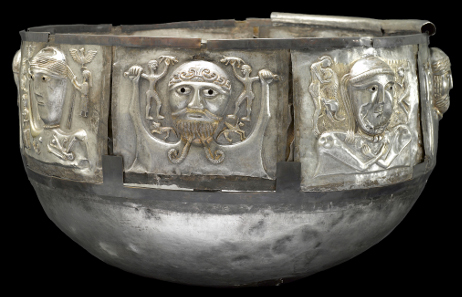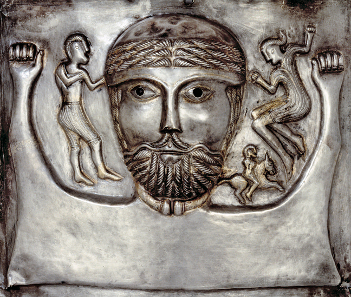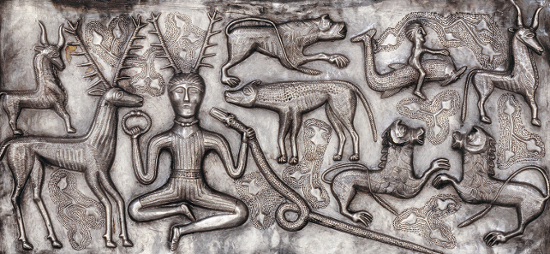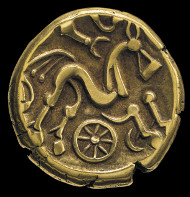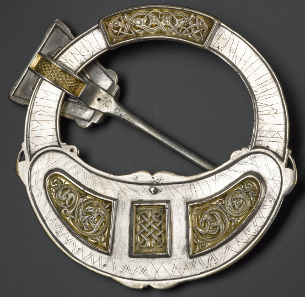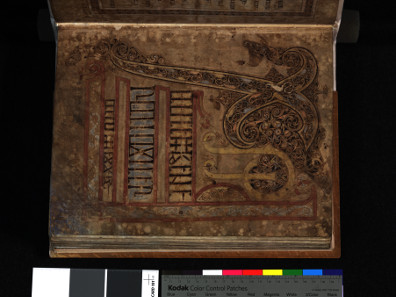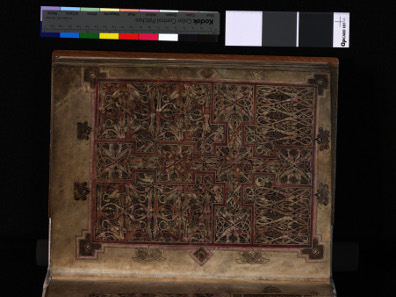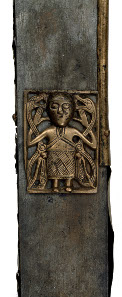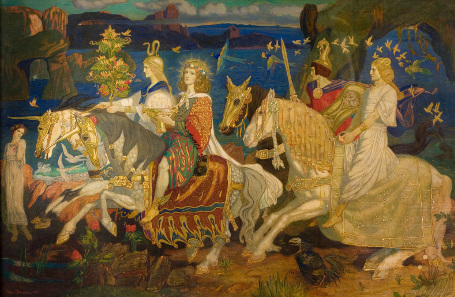October 1, 2015 – This autumn the British Museum, in partnership with National Museums Scotland, will stage the first British major exhibition in 40 years on the Celts.
Gundestrup Cauldron. Silver. Gundestrup, northern Denmark, 100 BC-AD 1. © The National Museum of Denmark.
The exhibition “Celts: art and identity” opened at the British Museum on 24 September 2015 and will draw on the latest research from Britain, Ireland and Western Europe. The exhibition will tell the story of the different peoples who have used or been given the name ‘Celts’ through the stunning art objects that they made, including intricately decorated jewellery, highly stylised objects of religious devotion, and the decorative arts of the late 19th century which were inspired by the past. The exhibition will then open at the National Museum Scotland in March 2016. As part of the National Programme activity around the Celts exhibition, the British Museum and National Museums Scotland will showcase two rare Iron Age mirrors as a Spotlight tour to partner museums across the UK.
Details of: Gundestrup Cauldron. Silver. Gundestrup, northern Denmark, 100 BC-AD 1. © The National Museum of Denmark.
Today the word ‘Celtic’ is associated with the distinctive cultures, languages, music and traditions of Scotland, Ireland, Wales, Cornwall, Brittany and the Isle of Man. Yet the name Celts was first recorded thousands of years earlier, around 500 BC, when the ancient Greeks used it to refer to peoples living across a broad swathe of Europe north of the Alps. The Greeks saw these outsiders as barbarians, far removed from the civilised world of the Mediterranean. They left no written records of their own, but today archaeology is revealing new insights into how they lived.
Iron Age Coin. Gold. Ruscombe, Berkshire, England, 50-20 BC. © The Trustees of the British Museum.
Modern research suggests that these were disparate groups rather than a single people, linked by their unique stylised art. This set them apart from the classical world, but their technological accomplishments stand on a par with the finest achievements of Greek and Roman artists.
A stunning example in the exhibition, from National Museums Scotland, is a hoard of gold torcs found at Blair Drummond in Stirling in 2009 by a metal detectorist on his very first outing. Excavations showed they had been buried inside a timber building, probably a shrine, in an isolated, wet location. These four torcs made between 300–100 BC show widespread connections across Iron Age Europe. Two are made from spiralling gold ribbons, a style characteristic of Scotland and Ireland. Another is a style found in south-western France although analysis of the Blair Drummond gold suggests it was made locally based on French styles. The final torc is a mixture of Iron Age details with embellishments on the terminals typical of Mediterranean workshops. It shows technological skill, a familiarity with exotic styles, and connections to a craftworker or workshop with the expertise to make such an object. The Blair Drummond find brings together the local and the highly exotic in one hoard.
Hunterston brooch. Silver, gold and amber. Hunterston, south-west Scotland, AD 700-800. © National Museums Scotland.
Although Britain and Ireland were never explicitly referred to as Celtic by the Greeks and Romans, some 2,000 years ago these islands were part of a world of related art, values, languages and beliefs which stretched from the Atlantic to the Black Sea. During the Roman period and after the fall of the Western Roman Empire, communities in Ireland and northern and western Britain developed distinct identities. The art and objects which they made expressed first their difference to the Romans, but later the new realities of living in a conquered land or on the edges of the Roman world.
St Chad gospels. Vellum. AD 700-800. Used by permission of the Chapter of Lichfield Cathedral.
These communities were among the first in Britain to become Christian, and missionaries from the north and west helped to convert the pagan Anglo-Saxons. The exhibition will include iron hand-bells used to call the faithful to prayer, elaborately illustrated gospel books telling the story of Jesus’s life, and beautifully carved stone crosses that stood as beacons of belief in the landscape.
Tully Lough Cross. Wood, bronze. Tully Lough, north-west Ireland, AD 700-900. © National Museum of Ireland.
An exceptionally rare gilded bronze processional cross from Tully Lough, Ireland (AD 700-800), will be displayed in Britain for the first time. Used during ceremonies and as a mobile symbol of Christianity, the design of this hand-held cross may have inspired some stone crosses, but metal examples rarely survive. Its decorative plates show the wider artistic connections of its makers: three-legged swirls and crescent shapes owe much to earlier Celtic traditions; other geometric motifs echo Roman designs, while interlace designs were popular across Europe and probably inspired by Anglo-Saxon art.
Iron Age pony cap. Bronze. Torrs, south-west Scotland, 300-100 BC. © National Museums Scotland.
The name Celts had fallen out of use after the Roman period, but it was rediscovered during the Renaissance. From the sixteenth century it became increasingly used as shorthand for the pre-Roman peoples of Western Europe. In the early 1700s, the languages of Scotland, Ireland, Wales, Cornwall, Brittany and the Isle of Man were given the name ‘Celtic’, based on the name used by the Greeks and Romans 2000 years before. In the context of a continually shifting political and religious landscape, ‘Celtic’ acquired a new significance as the peoples of these Atlantic regions sought to affirm their difference and independence from their French and English neighbours, drawing on long histories of distinctive local identities. First used by the ancient Greeks as a way to label outsiders, the word ‘Celtic’ was now proudly embraced to express a sense of shared ancestry and heritage.
The Riders of the Sidhe. Tempera on canvas. John Duncan, 1911. © Dundee City Council (Dundee’s Art Galleries and Museums).
Over the following centuries, the Celtic revival movement led to the creation of a re-imagined, romanticised Celtic past, expressed in art and literature such as the painting ‘The Druids: Bringing in the Mistletoe’ by George Henry and Edward Atkinson Hornel, 1890. Druids emerge from a grove of oaks where they have been ceremonially gathering mistletoe in this romantic Victorian reimagining of a scene described by Roman author Pliny the Elder. In an attempt to evoke an authentic Scottish past, the artists incorporated things that they thought of as Celtic: spiral motifs, the brilliant colours of illuminated manuscripts and a snake design inspired by Pictish stones. The painters claimed the faces were based on ancient ‘druid’ skulls. But the features of the central druid were really inspired by photographs of Native Americans.
Today, the word Celtic continues to have a powerful resonance. It calls to mind the ever shifting relationships between the different nations that make up Britain and Ireland, and their diaspora communities around the world. The idea of the Celts also confronts us with the long history of interaction between Britain and the rest of Europe.
Spotlight tour: Reflecting on the Celts
From Autumn 2015 to Autumn 2016, as part of the National Programme activity around the Celts exhibition, the British Museum and National Museums Scotland will profile two Iron Age mirrors, one discovered in England and one in Scotland, as a Spotlight tour to partner museums across the UK.
Balmaclellan mirror. Bronze. Balmaclellan, south-west Scotland, AD 80-250. © National Museums Scotland.
Metal mirrors with a polished reflective surface on one side and swirling designs on the reverse were first made around 100 BC. They are rare objects, and were only made in Britain. Two thousand years ago, these mirrors might have held a special kind of power in a world where reflections could otherwise only be glimpsed in water.
The two mirrors tell very different stories, revealing both similarities and local differences. The Spotlight Tour explores the relationships between communities across Britain 2,000 years ago, in a world that was being rocked by a new upheaval: the Roman conquest of southern Britain.
Desborough Mirror. Bronze. Desborough, Northamptonshire, England, 50 BC – AD 50. © The Trustees of the British Museum.
Neil MacGregor, Director of the British Museum said “the word Celtic brings together a series of moments across the history of western Europe when particular communities made art and objects that reflect a different, non-Mediterranean, way of thinking about the world. New research is challenging our preconception of the Celts as a single people, revealing the complex story of how this name has been used and appropriated over the last 2,500 years. While the Celts are not a distinct race or genetic group that can be traced through time, the word ‘Celtic’ still resonates powerfully today, all the more so because it has been continually redefined to echo contemporary concerns over politics, religion and identity.”
Gordon Rintoul, National Museums Scotland Director said “Encompassing the latest research from across Europe the exhibition explores the history of the peoples who became known as Celts and examines the powerful objects created and used by them. I am delighted that this collaboration with the British Museum has allowed us to present a stronger, more rounded exhibition than either of the institutions could have achieved on their own. I am sure that audiences in Edinburgh and London will find much to engage, enthuse and inspire them.”
Watch the curators showing you their favorite pieces at Youtube.
Here you will get all information about the exhibition at the BM including an impressive film featuring some spectacular objects.
If you do not want to queue up, you can book the tickets online.
If you won’t be able to attend, here you can buy the catalogue.
And this is the website of the National Museums Scotland, where the exhibition will start March 10, 2016.




